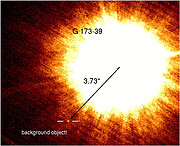Nature's Tiniest Stellar Twins
15 December 2006
A team of US astronomers led by Sebastian Daemgen (University of Arizona) has just released the results of a search for low-mass brown dwarf or planetary companions around young early-type M dwarf stars within 20 parsecs of the Sun.
The 41 stars in the survey have age estimates of < 300 million years, comparable to that of the Pleiades. Within the sample 13 objects are found to host fairly bright companions, eight of these (seven binaries and one triplet) are new discoveries (Figure 1). Understanding binarity or multiplicity rates in low-mass stellar systems could provide important clues on the formation of low-mass objects including planetary systems and their population of planets.
The survey was conducted using The Gemini North adaptive optics system ALTAIR in its natural guide star (NGS) mode. The strategy of the survey was to target young stars in order to increase the probability of finding intrinsically faint companions, such as large self-luminous Jovian planets. The team was able set a detection limit for faint companions of ΔKs ~ 7.8 magnitudes at separations greater than 0.5 arcsecond from the primary, and ΔKs >10 beyond 1.0 arcsecond separation.
The masses of the individual stars in the tiny M dwarf pairs vary between a bit less than 0.10 to 0.60 solar masses. The orbital periods of the pairs range from 6 to 477 years. The most likely separation between the components was found to be ~13 astronomical units (AU), which is less than the median value of the more massive solar type binary distribution. Yet, it is wider than that of the very low-mass (VLM) stars as determined by previous Gemini and Hubble Space Telescope studies.
No faint physical companions were found, despite the ability to detect them (see Figure 2). Hence, the team was able to exclude the presence of companions more massive than 10 MJup at > 40 AU or heavier than 23 MJup at > 10 AU. All planetary mass candidates were confirmed to be background objects.
Links
- "Discovery of 9 new companions to nearby young M stars with the ALTAIR AO system", by Sebastian Daemgen, Nick Siegler, I. Neill Reid & Laird Close, The Astrophysical Journal, Jan 1st, 2007 issue.



